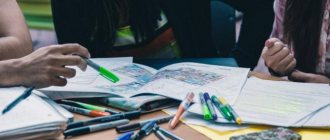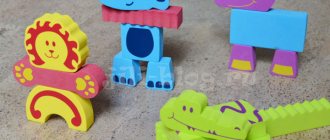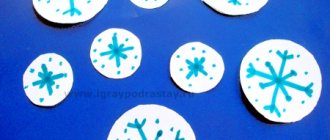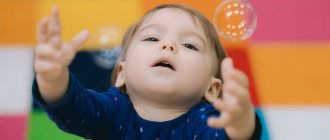Summary of an environmental lesson on the topic “Snowman and Christmas tree” in a group of children from 2 to 3 years old
Summary of an environmental lesson on the topic “Snowman and Christmas tree” in a group of children from 2 to 3 years old
Prepared by: Rakitina E.V.
Program content:
expand children's understanding of trees.
Develop a caring attitude towards plants, cultivate a desire to take care of them. Introduce the upcoming holiday - New Year. Age target:
children from 2 to 3 years old
Material:
Snowman toy, decorative Christmas tree, Christmas tree decorations.
Connection with other classes and activities:
New Year's holiday.
Learning poems about nature. Drawing a Christmas tree. Modeling a tumbler and a snowman. Integration of educational areas:
cognition, communication, artistic creativity.
Progress of the lesson There is a Christmas tree in the group room. The teacher invites the children to come to her. There is a toy snowman under the Christmas tree. The children greet him. Educator:
Snowman, isn’t it cold for you to stand here?
Snowman:
I’m not afraid of frost, I was made from snow, so I don’t freeze in the cold winter.
Thank you for coming to visit me. I want to show you my friend's Christmas tree. She is also very pleased that you came to visit us. The teacher invites the children to touch the branches of the Christmas tree and say: “Hello, Christmas tree!” Educator:
What branches does the Christmas tree have?
(children's answers). The branches are prickly. There are a lot of sharp green needles on them, but if you touch them carefully, you won’t prick your fingers and won’t hurt the Christmas tree. The Christmas tree is green and fluffy, there are many branches on it, and there are needles on the branches. At the bottom the branches are longer than at the top. Guys, what color are the Christmas tree needles? (children's answers). The Christmas tree differs from other trees in that it always has green needles in winter and summer. Other trees stand in winter without leaves, only snow shelters them from the cold and warms them during winter days and nights. And the Christmas tree always has green needles on its branches - both in winter and in summer. That's why people came up with a riddle about the Christmas tree: “In winter and summer, the same color.” Snowman:
In winter I admire the Christmas tree, but in summer I’m not here, because I would simply melt under the warm rays of the sun.
I heard that there is a holiday in your kindergarten soon. But Yolochka and I never had a holiday. We are so dreaming of a fun holiday! Educator:
Guys, what holiday will be soon?
(children's answers). That's right, New Year! Santa Claus will bring you gifts, and the Christmas tree will be festively decorated with multi-colored beads, balls and lights. Snowman, don’t be upset, the guys and I will decorate the Christmas tree and you will also have a holiday. Really, guys? The teacher takes out a box of Christmas tree decorations. Children and their teacher decorate the Christmas tree. Educator:
Well, the Christmas tree has become elegant and beautiful.
Snowman, are you not sad anymore? Snowman:
I’m very glad that Yolochka and I will have a fun holiday!
Thank you guys! Educator:
Guys, now the Christmas tree and the Snowman are in a good mood.
And so that they never get bored, let's make friends for them - snowmen. Children make balls from plasticine, and the teacher makes little snowmen out of them.
It smelled like a Christmas tree in our house, The lights were burning beautifully in the hall, And the chime of the clock called the guests to the New Year's carnival. The songs, dances, masks are ready, the heroes of the winter fairy tale will come. We promise you miracles, and happy new year!
Summary of educational activities on environmental education in the first junior group on the topic: “Snow”
FULL NAME. – Stepanova Alla Nikolaevna.
Position: teacher.
Educational institution: MDOU TsRR Kindergarten No. 12 “Teremok”, Pervomaisky village.
Theme of the lesson: “Snow”.
Educational field: “Cognitive development”.
Integration of areas: "Cognitive". "Artistic and aesthetic." "Social and communicative development." "Speech development".
Goal: To consolidate children’s ideas about the cold season, about winter natural phenomena, and to experiment with snow. Answer the teacher’s questions and draw simple conclusions.
Tasks:
-To consolidate children’s knowledge about winter natural phenomena (it’s cold, there’s snow, you can sculpt)
— Arouse in children the joy of perceiving real snow, develop tactile sensations, temperature differences (cold snow)
— Create children’s interest in the image using the principle of clarity
— Learn to connect circles together to create a snowman
— Expand vocabulary on the topic “Winter”, promote communication
— Learn to select mittens of the same color, name it
- Cultivate a desire to listen to poems
Planned results:
- has a basic understanding of snow
- can share information
- listens to poems that are accessible in content, communicates in dialogue with an adult
- participates with interest in games and activities, accepts the game task
Preliminary work:
Looking at illustrations, books with winter themes, observing on a walk, from the window: how the snow falls, where it lies. Conversations with children, reading poems, nursery rhymes, works about winter and snow. Playing out game actions.
Materials: cloud, snowflakes (crafts), snow on a tray, picture, snowmen - crafts, mittens of different colors, snowballs - crafts.
Content.
Children enter the group. The teacher asks: “Guys, what time of year is it now?”
- “Winter” - children’s answers.
- “Now look at our picture (winter landscape) and listen, I’ll tell you a poem:
A snowball is quietly falling on a clearing, on a meadow,
The snowflakes and white fluffs have settled down.
Yes, the teacher continues, there is a lot of snow outside in winter. Look, a snow cloud has “floated” to us” (shows a silhouette of a cloud cut out of cardboard with snowflakes attached to it on a clothespin), draws attention to how many snowflakes the cloud has.
Then the teacher detaches the snowflakes and says: “Look, the snowflakes are falling down, spinning in the air and lying on the ground. Take one snowflake at a time, place it on your palm and blow on them, they will fly (breathing exercises). Now let’s imagine that you and I are also light fluffy snowflakes.”
Psycho-gymnastics “Snowflakes”:
We are snowflakes, we are fluffs, we don’t mind spinning.
We are snowflakes - ballerinas, we fly day and night.
Snowflakes - fluffs are tired of flying.
They stopped spinning and sat down to rest.
We stand together in a circle, it turns out to be a snowball.
Educator: “Guys, if many, many snowflakes fly and stack one on top of the other, a lot of snow is formed (collects snowflakes from the children on a plate), look, we have a lot of snow formed (showing real snow on the tray).
Kids, let's touch the snow with our fingers. How does it feel to the touch, cold or warm? (cold). Look, it melts, turns into water, a droplet appears on your warm finger. That's right, snow is cold, it melts in warmth. What color is it? (white). What can you make from snow? (snowballs, snowman, slide).
And now I’ll show you how to sculpt a snowman out of snow: I’ll put on gloves, some kind of snow (cold) and I’ll sculpt a ball (I collect snowflakes, and I roll them into a ball). First, the large ball is the body (performing actions with snow), then the smaller ball is the head. Now I connect, on the head there is a hat (bucket), the nose is a carrot. So it turned out to be a snowman.”
Then the teacher says: “Guys, there are many of us, but there is only one snowman, let’s give him friends - snowmen (the children lay out snowmen on the table from paper circles, accompanying them with the words:
Our snowman is not simple, he appears in winter,
But in warmth it disappears because it melts quickly.”
While working, the teacher talks with the children, clarifies the properties of snow, helps connect the parts, attach a nose - put a carrot on a hat for a snowman, etc.
Teacher: “Guys, the snowman is cold, he wants to freeze your hands, let’s put on mittens” (the teacher hands out one mitten of a different color to each child), the children put it on, and then look for another mitten of the same color. The teacher specifies the colors of the mittens and says: “Now our hands won’t freeze. Do you want to play in the snow? (children agree). Reads a poem:
One, two, three, four - we made snowballs together.
Once - we'll throw it, twice - we'll catch it and we'll start playing snowballs.
(Children imitate rolling snowballs out of snow).
The teacher distributes snowballs to the children - crafts, the children play, and suddenly throw snowballs at each other.
Take care of these lands, these waters, loving even a small epic. Take care of all the animals inside nature, Kill only the animals inside yourself!
E. Yevtushenko.
Summary of a lesson on ecology in the junior preschool group “I am part of nature”
Bibliographic description:
Stepanova, A. V. Summary of a lesson on ecology in the junior preschool group “I am part of nature” / A. V. Stepanova. — Text: direct // Questions of preschool pedagogy. - 2022. - No. 10 (47). — P. 119-126. — URL: https://moluch.ru/th/1/archive/208/6677/ (access date: 01/19/2022).
Educational field and direction: environmental education.
The purpose of the lesson is to develop in children (from 1.5 to 3 years old) ideas about the world of plants and animals, as well as a correct and caring attitude towards them.
Tasks:
— Contribute to deepening children’s knowledge about the natural world, plants, wild animals and birds.
— To foster children’s interest in the forest world and its inhabitants, to promote caring attitude towards animals and plants.
Integrated educational areas: cognitive, speech, social and aesthetic development.
Preliminary work: demonstration of visual materials with images of plants, mushrooms and berries, as well as forest animals using a presentation.
Demonstration material: presentation “I am part of nature”, indoor plant, watering can with water, spatula.
Handouts: drawings of mushrooms and berries, coloring drawings with animals, crayons and pencils.
Progress of the lesson:
Educator: Children, today we will go on a small but very amazing journey, where do you think? I'll give you a hint, now I'll tell you a riddle, and you guess:
“Squirrels and wolves live in it,
Oak trees and fir trees grow in it
Tall - to the skies!
They call him...”
Children: Forest!
Educator: Forest! Right! Today we will go with you to the beautiful world of nature. This is what surrounds us, what pleases our eyes and inspires us, what many writers write about.
Educator: Let's look at the screen together, look carefully at the trees. Do you know them, have you met them before when you were walking?
Children: Yes
Teacher: *comes to the table with a flower to demonstrate how to care for it for children*
Did you know that trees are a source of oxygen, what we use to breathe, and therefore we need to take care of trees and plants. Could you take care of plants?
Children: Yes
Educator: *demonstrates the process on a houseplant* Do you know what to do? Now I will show you how we can take care of indoor plants. Flowers love the sun as much as we do, so they need sunlight and clean air to grow. Flowers also love to drink water, so we must water the flowers and loosen the soil for proper and rapid growth [2, p. 76].
Educator: Flowers and plants grow not only on our windowsill, but also in the forest. Let's head to our forest corner.
Teacher and children: *come to the screen (presentation with the forest and its inhabitants) *
Educator: The forest is a home for many animals, it is rich in trees, plants and birds. The forest treats us with berries, nuts and mushrooms (we show it in the picture and tell you about it).
Educator: Do you know that not all mushrooms and berries can be eaten? You need to be able to distinguish between edible and inedible mushrooms and berries. When we go into the forest to get them, we will collect only edible mushrooms in our basket, for example, porcini mushrooms, chanterelles, and honey mushrooms. Under no circumstances will we put poisonous mushrooms in our basket, for example the well-known fly agaric, as well as toadstool. Among the berries there are also edible ones, for example, strawberries, cranberries and blueberries, and inedible ones, which are also dangerous to our health, for example, wolfberry and crow's eye, look at the screen [1, p. 107].
Assignment: Now let's go into the forest and collect our own basket *there are drawings of mushrooms and berries on the floor, the kids are collecting edible mushrooms and berries* (Appendix 1).
Educator: How many mushrooms and berries do you know! How amazing! You can even go on a visit with such an edible basket. Let's visit our forest animals, are you ready?
Children: Yes!!!
Educator: The forest is home to many animals, for example, foxes, bears, wolves, squirrels and hedgehogs live there, and we can also see deer and elk.
Assignment: At the end, you are given the next mission, you must collect the animals in their forest home, decorate your animals and in the end we will unite them together! *hands out coloring books with animals, crayons and pencils to the children* (Appendix 2).
Annex 1
Appendix 2
Literature:
- Nikolaeva, S.N. Young ecologist: program of environmental education in kindergarten / S.N. Nikolaeva. - M.: Mozaika-Sintez, 2010. - 107 p.
- Nikolaeva, S. N. Young ecologist: a system of work in the younger group of kindergarten: for working with children 2–4 years old / S. N. Nikolaeva. - Moscow: Mosaic-Sintez, 2010. - 76 p.
- Solomennikova O. A. Classes on the formation of elementary environmental ideas. The first junior group of kindergarten. Class notes - M.: Mozaika-Sintez, 2007. - 48 p.



